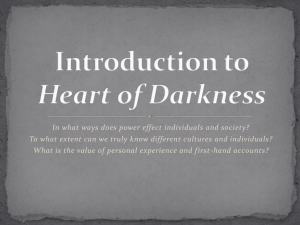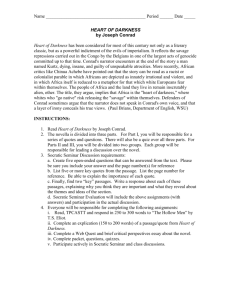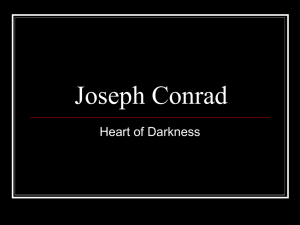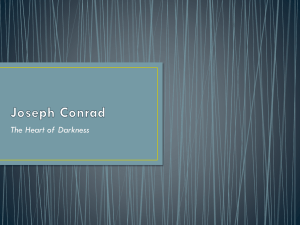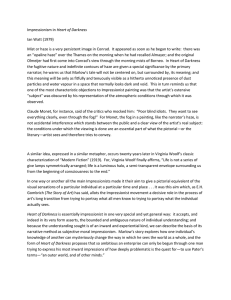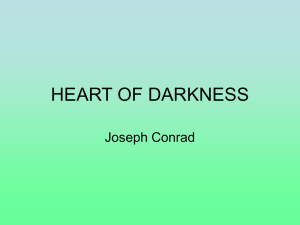Document 10454245
advertisement
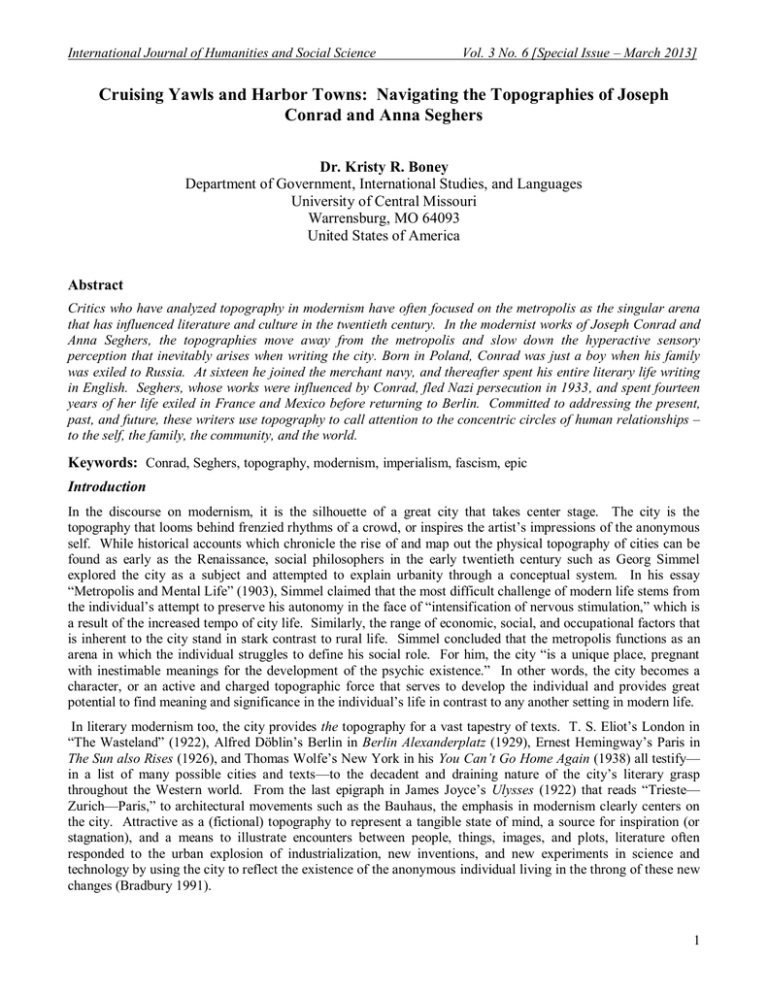
International Journal of Humanities and Social Science Vol. 3 No. 6 [Special Issue – March 2013] Cruising Yawls and Harbor Towns: Navigating the Topographies of Joseph Conrad and Anna Seghers Dr. Kristy R. Boney Department of Government, International Studies, and Languages University of Central Missouri Warrensburg, MO 64093 United States of America Abstract Critics who have analyzed topography in modernism have often focused on the metropolis as the singular arena that has influenced literature and culture in the twentieth century. In the modernist works of Joseph Conrad and Anna Seghers, the topographies move away from the metropolis and slow down the hyperactive sensory perception that inevitably arises when writing the city. Born in Poland, Conrad was just a boy when his family was exiled to Russia. At sixteen he joined the merchant navy, and thereafter spent his entire literary life writing in English. Seghers, whose works were influenced by Conrad, fled Nazi persecution in 1933, and spent fourteen years of her life exiled in France and Mexico before returning to Berlin. Committed to addressing the present, past, and future, these writers use topography to call attention to the concentric circles of human relationships – to the self, the family, the community, and the world. Keywords: Conrad, Seghers, topography, modernism, imperialism, fascism, epic Introduction In the discourse on modernism, it is the silhouette of a great city that takes center stage. The city is the topography that looms behind frenzied rhythms of a crowd, or inspires the artist‟s impressions of the anonymous self. While historical accounts which chronicle the rise of and map out the physical topography of cities can be found as early as the Renaissance, social philosophers in the early twentieth century such as Georg Simmel explored the city as a subject and attempted to explain urbanity through a conceptual system. In his essay “Metropolis and Mental Life” (1903), Simmel claimed that the most difficult challenge of modern life stems from the individual‟s attempt to preserve his autonomy in the face of “intensification of nervous stimulation,” which is a result of the increased tempo of city life. Similarly, the range of economic, social, and occupational factors that is inherent to the city stand in stark contrast to rural life. Simmel concluded that the metropolis functions as an arena in which the individual struggles to define his social role. For him, the city “is a unique place, pregnant with inestimable meanings for the development of the psychic existence.” In other words, the city becomes a character, or an active and charged topographic force that serves to develop the individual and provides great potential to find meaning and significance in the individual‟s life in contrast to any another setting in modern life. In literary modernism too, the city provides the topography for a vast tapestry of texts. T. S. Eliot‟s London in “The Wasteland” (1922), Alfred Döblin‟s Berlin in Berlin Alexanderplatz (1929), Ernest Hemingway‟s Paris in The Sun also Rises (1926), and Thomas Wolfe‟s New York in his You Can’t Go Home Again (1938) all testify— in a list of many possible cities and texts—to the decadent and draining nature of the city‟s literary grasp throughout the Western world. From the last epigraph in James Joyce‟s Ulysses (1922) that reads “Trieste— Zurich—Paris,” to architectural movements such as the Bauhaus, the emphasis in modernism clearly centers on the city. Attractive as a (fictional) topography to represent a tangible state of mind, a source for inspiration (or stagnation), and a means to illustrate encounters between people, things, images, and plots, literature often responded to the urban explosion of industrialization, new inventions, and new experiments in science and technology by using the city to reflect the existence of the anonymous individual living in the throng of these new changes (Bradbury 1991). 1 The Special Issue on Behavioral and Social Science © Centre for Promoting Ideas, USA www.ijhssnet.com Charles Molesworth (1991) wrote about the tenuous and ungraspable nature of the city when he intimated that it is a “stage where staging itself occurs […] the city is the place where everything is both available and vanishing, then we can also see it as the stage in which all prosceniums are unfolding and disappearing.” More specifically, Wolfgang Schivelbusch (1989) investigated the railroad and its effect on the city in which he pointed out that the railroad not only reorganizes space, but also it changes how we understand (experiential) space and time. Schivelbusch explains that one of “the essential new stimuli of the train journey is speed, [...] This new stimulus at first merely irritates the traveler, who is still accustomed to the old velocity of the coach. Yet gradually everything connected with the new velocity becomes psychically assimilated.” As a result, the gaze of the train traveler differs from the coach (or the sea) traveler in that the landscape becomes limited and diminished due to velocity. Thus, focusing the perspective on the sea has an opposite effect to experiencing the city, and the steady concentration calms the anxiousness or layer of consciousness predisposed to a face-paced blur. Ultimately, the city transforms the way we view space and creates an urban consciousness. New markers of urban space denote a fleeting and transitory presence that can be investigated through topography and— akin to Simmel‟s assessment— the city becomes something to write, a stimulus that showcases intricate processes of emancipation, isolation, connection, estrangement. Modernism concerns itself with crises, and understanding modernism derives from un-mapping the confusion of the crises and charting out terms, goals, and directions modernist writers take. Though Simmel and others rummaged around the city, some modernist writers, such as Joseph Conrad, Anna Seghers, and Virginia Woolf— and at times—James Joyce and Ernest Hemingway steered away from writing the city and anchored their topographies instead in waterscapes or sleepy towns. Arguably, adventure tales which incorporate the sea date back as far as Homer and the Bible—the sea and its surroundings have always been a common source for storytelling inspiration. Yet in contrast to the city which can show the modern flux of change and present the intersections that occur between the public and the individual, the sea provides a topography that stretches beyond illustrating anxiety or an influx of stimuli—it is free of the city‟s mass, rough edges, and the friction of buildings. As a topographical concept, or as a texture in the narrative, the sea slows down the hyperactive sensory perception that inevitably arises when writing an urban topography and it focuses instead on the act of storytelling itself. For Joseph Conrad and Anna Seghers, two writers from two different countries, topography certainly becomes crucial to their narratives. In his “Tales of the Sea” (1898), Conrad explained that the sea was a stage, where “we find the mass of the nameless, that we see them in the flesh.” Orphaned, Conrad left Poland and eventually became a sailor. His sailing experience—including his trip to the Belgian Congo which informed much of Heart of Darkness (1899)—became the basis of his oeuvre. The sea becomes a dynamic realm, a topography that becomes part and parcel of the intricate texture of Conrad‟s yarns. Conrad may not have been an intimate contemporary of Anna Seghers, but he was certainly a literary influence. Before Seghers had started her publishing career, she already had several of Conrad‟s texts in her personal library (Fehervary 2001), and she once praised Conrad for his ability to write for the people (Seghers 1989). Seghers grew up in Mainz, and many of her texts incorporate rivers and water as a principle motif. In her Überfahrt (1971), a later text that still exhibits modernist trends, Seghers actually named one of the Polish ships the Josef Conrad and explicitly referred to Conrad‟s Heart of Darkness. Her most life-changing experience that connects to the sea occurred in March 1941, when Seghers and her family departed for Mexico on one of the last refugee ships in Marseille. This experience of exile and flight is immortalized in her Transit (1944). Like Conrad, Seghers incorporated the obvious influence of water and used it as a topographical frame for many of her stories. For Conrad and Seghers, the sea certainly lends itself as a topography for spinning good stories. For them, the sea is an organizing principle that helps to understand, define, and describe a modernist experience. Each uses the sea to make a different statement for a different historical crisis. While Conrad was concerned with imperialism, Seghers was horrified by fascism. The water topographies ebb in and out of the tale, splash and lap over onto all the levels of narration. They become not only a narrative device, but also an integral and active element to the story that inscribes the narrative with a corporeal texture and form that provides an insight into the crisis of modernity in a way that classic modernist city narratives do not. In Heart of Darkness (Conrad 1988), the Thames, the Congo, the Nellie, and the steamer that Marlow navigates through the jungle make up a topography of waterscapes that is more promising and durable than the urban symbols that crop up. The narrative relates the personal journey of the seaman Marlow as he voyages down the Congo to retrieve the illustrious Kurtz, an ivory collector who has gone missing. 2 International Journal of Humanities and Social Science Vol. 3 No. 6 [Special Issue – March 2013] Topography in Joseph Conrad’s Heart of Darkness The story opens on a “cruising yawl” just below the town of Gravesend, a small harbor town that lies twenty-six miles east of London. Though the narrator refers peripherally to London, he calls it “the biggest, and the greatest, town on earth” and describes it as cloaked in a “mournful gloom” (Conrad 1988, pp. 7). The ship is waiting for the turn of the tide and the initial unnamed narrator—before Marlow interrupts—belongs to a group of professional men. Significantly, the travelers on the Nellie are part of the urban machinery that fuels the ivory trade and subsequently imperialist practices. The group includes a Director of Companies, an accountant, and a lawyer. Though the narrator does not specify his relation to the others beyond “the bond of the sea,” it is clear that the passenger cargo consists of men affiliated with a shipping company which makes its profits from harvesting wealth from other lands (Conrad 1988, pp. 7). Marlow‟s function—though he is likely a pilot—is also unspecified. His presence clearly comes across as being one of an outsider. The narrator makes it known that the director of the shipping company captains the Nellie, “though it was difficult to realize that his work was not out there in the luminous estuary, but behind him within the brooding gloom (Conrad 1988, pp. 7)”. The director performs his duty as captain purely in a ceremonial manner. Except for Marlow, these men plainly comprise the financial appendage of the city—all of them seek fortune in a commercial, urban center. Conrad placed their role within the city in opposition and estrangement to water—their part resides in “gloom” (or urbanity) while the tale takes place on “luminous” water. In fact, within the first few pages Conrad used the term “gloom” no less than five times to refer to London: The “mournful gloom brooding motionless” over London (Conrad 1988, pp. 7); the director‟s work “within the brooding gloom” (Conrad 1988, pp. 7); the “gloom to the west” (Conrad 1988, pp. 8); the setting sun sank low, as if it were “stricken to death by the touch of that gloom” (Conrad 1988, pp. 8), and on the Thames fairway, the ships move farther west towards London, which was “a brooding gloom in sunshine” (Conrad 1988, pp. 9). Even in the first scenes the water resides and functions in a realm outside of the city. The ensuing description suggests that the water has a more privileged status: It is more weightless and resplendent, and it is not burdened by modern practices or machinery. Moreover, the voyage into the jungle provides a topography that contrasts and criticizes the spirit of modernity. While recounting to his audience his first assignment as a steamer captain, Marlow describes the difficult, physical task of guiding the steamer through the shallow waters of the Congo. In doing so, he throws a barb at the passengers from the city for forgetting the true and “inner” reality of life due to the (untrue) abstract pursuit of capitalist gain. Though his urban audience objects, Marlow intimates that on the river the “inner truth is hidden— luckily, luckily. But I felt it all the same; I felt often its mysterious stillness watching me at my monkey tricks, just as it watches you fellows performing on your respective tight-ropes, for—what is it? half a crown a tumble . . . (Conrad 1988, pp. 36)”. Marlow suggests that the voyage on the steamer offers transcendence, while the urban gloom obscures moments of enlightenment about the “truth” behind the quest for wealth. Though the mysterious stillness Marlow refers to is part of Conrad‟s murky “adjectival insistence” that characterizes humanity (Leavis 1972), Conrad underscores this contrast between the city and water from the onset: The narrator describes the setting sun on the Thames as one in which the bright white—a common symbol for Enlightenment—is muted by the urban gloom. Put differently, the critique of the urban quest filters through the waterscape, makes its presence felt, and becomes a moral comment, revealing that baser instincts always inform human motivation. The “luminous” nature of the water becomes an opportunity for introspection in which the inner gaze can delve into the fundamental corruption of imperialism. To that end, Conrad used waterscapes and later incorporated the jungle to provide a topographical representation of the modern quest for wealth. When Marlow arrives at the company‟s station, he sees a decrepit boiler, a used railway truck, and men senselessly blasting away at a cliff, and finally decaying drainage pipes (Conrad 1988, pp. 19-20). The images testify to an endpoint—that the quest for wealth and industrial progress ends in corrosion. The station (or the beginnings of urbanity) illustrates the teleological degenerative effect of the quest for wealth that is part and parcel of the city. Simmel reflected on this degenerative cycle when he traced the phenomena of the money economy and its role in modern life. He asserted that money generally functions as serving a purpose and simultaneously an end, and in doing so money degrades the “means” which should be the “ends.” Money resides in everything, and to everybody money is an end and a means, which finally links all of life into a teleological relationship (Simmel 2004). Money is a crucial component of modern life (or imperialism) and it is also a major symbol since its fundamental reality renders the world intelligible. 3 The Special Issue on Behavioral and Social Science © Centre for Promoting Ideas, USA www.ijhssnet.com The company station gives a topographical shape to the modern urban spirit in that it degrades the means which should be the ends—the decrepit boiler and decaying equipment provide visual markers to criticize the ivory trade. In other words, searching for fulfillment through wealth and exploitation will only result in rot. Thus, it is no surprise that at the company station Marlow declares that he “had stepped into the gloomy circle of some Inferno. The rapids were near and an uninterrupted, uniform, headlong rushing noise filled the mournful stillness of the grove […] with a mysterious sound” (Conrad 1988, pp. 20). Again, the urban markers are replaced with “gloom,” and the “luminous” water can be heard, underscoring the disillusionment with the quest for wealth. While criticism of Heart of Darkness typically interprets the text as an antagonism of the modern, “civil,” and urban with the primitive, native, and jungle (Cox 1974), the dialectic between urbanity and waterscapes is not always straightforward. The water‟s “mysterious stillness” and “luminosity” simplifies the perspective and changes focus to something less fast-paced and more enduring and concrete. When repairing his boat at the Central Station, Marlow asserts that it was comforting to navigate “the battered, twisted, ruined tin-pot steamboat” (Conrad 1988, pp. 31). Despite its decrepit state, the ship differs from the rotting truck in that it allows for a concrete resiliency. As an element, tin is malleable, soft, and silvery-white. It is lighter, and does not get tangled in the undergrowth of the jungle like steel or lead, and the visual and aural clues of passing time testify to a long-lasting endurance and permanence. The jungle snares, entangles, and ultimately lays bare the already crumbling nature of imperialism, which is the crisis of modernity for Conrad. Working on the boat for the purpose of continual navigation (and not for personal wealth) keeps Marlow‟s concentration afloat, and allows him to have a broader perspective of humanity. Ultimately, Conrad went beyond the dialectic between the city and the jungle, and sought to illustrate more than its origins. The Congo becomes metonymical for the many stages of the modern arena. Conrad gives a gravity and shape to imperialism that illustrates rot and decay as its skeleton, whereas the knowledge of the roots that effuses from the steamer rings clear and solid like tin. Topography in Anna Seghers’ Transit Similar to Conrad‟s personal experience and disillusionment with European imperialism in the Congo, Seghers wrote Transit out of the desire to describe and explain the situation of resistance, emigration, and flight during World War II. In the foreword of the 1950 Czech edition of Transit, Seghers wrote that she began the novel in the first year of war in France as she was trying to secure transit for herself and her family while her husband, Laszlo Radvanyi was interned in Le Vernet, a camp in the Pyreneans (Seghers 2001, pp. 286). She finished it on the voyage to Martinique (and ultimately Mexico). In her commentary to Transit, Sylvia Schlenstedt explains the background of Transit as an attempt to understand (begreifen), and to make others understand, since Seghers herself was certain that the experience was incomprehensible (unbegreiflich) for others (Seghers 2001, pp. 317). Like Conrad‟s London, Paris is besieged by a more recent example of imperialism—fascism—and Marseille becomes the last “outpost” of those attempting to flee Europe before the Holocaust. In that sense, the old harbor café where the narrator settles to tell his yarn becomes akin to Marlow‟s stage on a resting yawl. The narrator invites the anonymous listener to a glass of wine and a piece of pizza (Seghers 2001, pp. 5), but he is already at the site of what Kurtz calls the “horror.” He informs his listener in the very first sentence about the alleged sinking of the Montréal, a refugee ship bound for Martinique. The narrative unfolds the collective story of refugees seeking escape from Nazi persecution. Specifically, Seghers‟s narrator—who is never named—tells his story of how he came to Marseille, and how he came into possession of Weidel‟s papers, an author who had committed suicide when the Germans invaded Paris in June 1940. In his attempt to give the papers to the Mexican authorities, the narrator‟s identity becomes confused with Weidel and follows him when he goes to Marseille. In Marseille, the narrator meets and becomes enamored of Marie, Weidel‟s widow, who tirelessly searches the harbor for her dead husband, based on the rumors that people have seen him alive. The narrator does not tell Marie that her husband is dead and tries instead, unbeknownst to her, to use his mistaken identity to help her receive transit. As in Heart of Darkness, the waterscapes and sleepy harbor trump the city topography. The narrative begins initially in Paris, but then later changes to Marseille, and the narrator consistently oscillates between describing a bustling modern city and a pre-modern harbor town. Transit compares to Heart of Darkness in that Seghers drew stark differences between two types of cities, but her topographical paradigms differ. While Conrad used his waterscapes to comment morally on the rise of the imperialist city, Seghers focused on the specific. Subsequently, her topography becomes actively charged as a mapped-out monument to a particular present and past. 4 International Journal of Humanities and Social Science Vol. 3 No. 6 [Special Issue – March 2013] J. Hillis Miller (1995) referred to this phenomenon of topographical writing when he argued that “topography as not a pre-existing thing in itself. It is made into a landscape, that is, into a humanly meaningful space, by the living that takes place within it.” Instead of delving into the degenerative nature of imperialism, Seghers contrasted the urban Paris with the harbortown of Marseille, a harbor situated on the very Mediterranean Sea to which (Conrad‟s) Africa connects. Contrary to Conrad, Seghers used fewer topographical waterscapes in Transit and incorporated them instead as they connect to an older version of a city, thus creating a tighter seam between the two areas, rather than a stark contrast between the urban gloom and the jungle. While Seghers used urbanity in Transit, her privileging of the harbor town had less to do with metaphors and symbolism and more to do with a conscious attempt to preserve a moment of crisis within history. The city in Transit—in this case Paris—takes on a greater role than it does in Heart of Darkness. While the similarities between Seghers‟s personal experiences and the narrator‟s fictional ones have been documented, less devotion has been given to the description of Paris as it compares to other modernist descriptions of urban centers. In this text Paris is the center of deadness, on which a gloom—much akin to Conrad—rests. The city is crowded and the frenetic pace of modernity coupled with the desperate anxiety caused by the Nazi presence floods the narrator‟s senses, leaving him brooding and emotionless (Seghers 2001, pp. 13). Seghers‟s two old women selling newspapers match up to the two knitting women in Heart of Darkness. They signify urban emptiness in their “uralten gegenseitigen Haß” (“age-old mutual hate”) by trying to sell more, earn more, and outdo the competition (Seghers 2001, pp. 15). The narrator does not describe a brooding gloom based on economic gain, but instead looks to the historical cityscape markers and documents the excessive number of swastika flags covering the city. He too labels the city as gloomy. It is infected with cafard—a deep boredom and ominous emptiness that is exacerbated by the Nazi flags (Seghers 2001, pp. 25). Similar to Conrad‟s “whited sepulchre,” of London (Conrad, 1988, pp. 13), Paris has turned from being a delightful mystery into an immeasurable pit of darkness and death. For Seghers, however, the reason behind the boredom stemmed from Nazi persecution. Akin to Simmel‟s assessment of the city, nervous stimulation and subsequent numbness certainly apply to Seghers‟s Paris, but she attributed this particular urban entropy to the reality of the Nazi occupation. The narrator often follows a city image with a reference to the oppression by the Germans. The energy has changed to fear as an “unermüdliche Schar von Beamten war Tag und Nacht unterwegs wie Hundefänger, um verdächtige Menschen aus den durchziehenden Haufen herauszufangen” (“indefatigable host of public officials were constantly day and night on the go like dog-catchers, in order to catch suspicious persons out of the massive heaps,” Seghers 2001. pp. 37). Another image includes two Nazi guards joking about a young girl‟s interrogation and the loss of her husband (Seghers 2001, pp. 15). The Nazi presence creates an anxiety that results in bitterness and deadly paranoia: Weidel‟s suicide, the hotel receptionist‟s fear of being found in illegal possession of Weidel‟s papers, and the annoyance of the narrator‟s host when the narrator did not procure a bread ration card all amplify a new form of modernist anxiety that is connected to an exclusive historical urbanscape. Just as Conrad became disillusioned with the exploitation of Africa, Seghers was deeply concerned about the German/Italian fascist expansion: By 1940, it included Austria and Czechoslovakia (1938), Poland (1939), as well as Belgium, Norway, Denmark, and the Netherlands (1940). Similar to Marlow‟s predilection to focus on the Thames as a site of imperialist conquest; the narrator of Transit invites his audience to focus not on the city or the fire from the café, but on the old seaport, so as not to become bored during his story (Seghers 2001, pp. 5). This focus becomes akin to Conrad‟s “mysterious stillness” when Marlow gazes on the water and broods aloud. The narrator in Transit is sitting in a café in the old harbor of Marseille and is thus detached from the movement of the metropolis. And much like Heart of Darkness, the narrator in Transit is waiting: He waits for news about Marie‟s ship, the Montréal (Seghers 2001, pp. 5). The difference between Seghers and Conrad, however, is that the sea and the ship in Transit perform a political function—they are the only means of escape from Europe. The Montréal and all the ships in Transit take on a greater sense of urgency than do the cruising yawls and rugged tin-pot steamers. The narrator points out that these ships—“a weak hope” (Seghers 2001, pp. 69)—are burdened with refugees who are hunted through all the oceans and are never received in the ports. They are burned on the high seas before the anchor is allowed to settle because the passengers‟ papers have expired (Seghers 2001, pp. 5). 5 The Special Issue on Behavioral and Social Science © Centre for Promoting Ideas, USA www.ijhssnet.com Still, they offer the possibility of escape. Thus, when the narrator first enters Marseille and sees the harbor town and the shore, the effect, he says, calms him (Seghers 2001, pp. 41). The “calm” cannot be construed as the same “serenity” the passengers experience on the Nellie as they leave London. While Conrad warned against the horror that humanity can perpetuate, Seghers‟s narrator makes it clear that it seemed as if death with its swastika flags always seemed close (Seghers 2001, pp. 69-70), even when the narrator was pleased to be so close to escape. As a result, the Mediterranean harbor in Transit provides a broader perspective. The sea, “that innocently glittered between the houses (Seghers 2001, pp. 69),” certainly lulls the nervous tension exacerbated by Nazism, but that awareness is always tinged with a political urgency. Interestingly, the location of the café where the sunset can be watched is situated behind Fort St. Nicolas, a fort that was erected by Louis XIV to discourage further manifestations of resistance by the inhabitants of this harbor town against royal absolutism. Thus, Seghers‟s topography has a mnemonic power: it consistently has had an active role in resistance movements, and even the Nazis did not occupy Marseille immediately. It is no surprise that in the end the narrator articulates his determination to remain close to Marseille and defend it (Seghers 2001, pp. 278-279). Seghers‟s insistence on guiding the perspective away from the fleeting impressions of city life to the steady perspective of the sea restores a larger objectivity in a specific emotionally-ridden timescape: There is an insight into a purer and more elemental purpose of life. The harbor allows for a primacy of vision that—in a tale meant to describe “the indescribable”—Seghers‟s narrator cannot observe the crises typical of urban life, but has to investigate the entirely new experience of life affected by fascism. Epic Topographies Although Seghers concerns herself with fascism and Conrad imperialism, each writer uses water to expand their topography beyond a specific timescape and thus delve into elements of the epic. Heart of Darkness and Transit already hearken to the epic in that the narrators are distanced from the narrated events and prefer to observe rather than participate. Also, their perspective of events is broader rather than singular in nature—they become the medium that explains the events of humanity to the listener. But finally, haze, in connection to the riverscape, plays an important role in bridging the stories with elements of the epic. As a natural phenomenon connected to water, haze bridges the gap between the tangible present of modernity and a mythical past or pre-modernity. While the narratives are placed within a tangible and physical geography, a fog or a haze arising from the waterscapes obscures the main subject of detail. In contrast to a particular geography, the use of haze as a device countervails the corporeality that arises from place naming—solidarity, durability and continuity are disrupted and displaced by discord, fragility, and disruption. The disruption of sight that the haze causes does not differ so much from the fleeting and indiscernible patterns of the modern city as it can be viewed from the blurred vision of a train window. Haze cloaks the subject while a train window distorts it, and the effect is not dissonant fragmentation, but rather haze dampens and mutes the subject. Despite its ambiguity, the outline is still present. Whether as a result of the rise of the city or not, one of the general tenets of modernism is a move away from traditional concepts of objectivity to subjectivity in order to detail the world and its surroundings more realistically. Certainly one of the paths towards subjectivity can be found within city narratives, but using haze from the waterscapes lends itself not only as a device to obscure the narrative, but also as another way of ordering this modern and unruly cosmos, while still connecting it to an older and more permanent past. The fog or haze that envelops the narrative terrain of Heart of Darkness constantly mars Marlow‟s “vision.” Not only does haze appear aboard the Nellie, but haze and fog cloak the entire tale: when Marlow begins his tale he refers to early conquerors in a darkness with a “sky the color of smoke” (Seghers 2001, pp. 7); when he accepts his first commission, there was “something ominous in the atmosphere” (Seghers 2001, pp. 14); when he boards the French steamer bound for the first station, he describes “a blue sea whose glitter was blurred by a creeping mist. The sun was fierce, the land seemed to glisten and drip with steam” (Seghers 2001, pp. 16); when Marlow‟s steamer is finally ready to depart in search for Kurtz, a “white fog” blinds the way, and in the end, after Marlow has told his tale, the “offing was barred by a blank bank of clouds, and the tranquil waterway leading to the uttermost ends of the earth flowed somber under an overcast sky” (Seghers 2001, pp. 76). Marlow, as an appendage of the sea, has trouble narrating linearly when the haze obscures his view. In fact, the unnamed narrator feels compelled to introduce and explain Marlow‟s hazy style. 6 International Journal of Humanities and Social Science Vol. 3 No. 6 [Special Issue – March 2013] To him, “the meaning of an episode was not inside a kernel, but outside, enveloping the tale which brought it out only as a glow brings out a haze” (Seghers 2001, pp. 9). Despite the concrete and audio clarity of the tin steamer, haze obscures any palpable interpretation. While Ian Watt suggests that Conrad‟s storytelling has an impressionistic element, tracing the haze as an impressionistic device is quite useful in that impressionist painting relies on the notion that the main subject remains cloaked or obscured (Seghers 2001, pp. 312). Yet the mistiness functions in two capacities. The obscurity cloaks the horrific and transformative power that is “too dark altogether” to deal with in its full outline (Seghers 2001, pp. 74), but it also bridges a past and present African topography with a past and present English one. Already in the beginning the narrator contrasts the gloomy London and “the very mist on the Essex marshes [that] was like a gauzy and radiant fabric hung from the wooden rises inland and draping the low shores in diaphanous folds” (Seghers 2001, pp. 8). The topography of the land—as observed from the deck—is calm, quiet, and tranquil, and the emphasis ebbs between stasis and expectancy much like the ripples in the water. The narrator describes with mythical invocations the river Thames as “crowded with memories of men and ships” (Seghers 2001, pp. 18). Out of the haze, the riverscape reaches out beyond identifying a setting and connects to an overarching human consciousness. Conrad was not simply referring to English imperialism, but the centuries of past conquest by the Romans, the Celts, and the Saxons. Haze and shadows certainly cloak the revulsion of England‟s past, but they also dress the myth of England‟s great past. Through its seamless cover, haze blurs the rough edges of the city, and it softens the years of time to show that this land too “has been one of the dark places of the earth” (Seghers 2001, pp. 9). In explaining myth, Hans Blumenberg (1985) correctly wrote that in “myth there is no chronology, there are only sequences. Something that lies very far back, but in the meantime has not been contradicted or pushed aside; it has an assumption of trustworthiness on its side.” The mist and haze that drape England and Africa lend an element of fluid tranquility that allows an encompassing reflection on “abiding memories” (Conrad 1988, pp. 9). Marlow‟s hazy narration and his topography reach back into a credible and epic representation of world history—myth becomes the geography, so to speak, with the archetypes as solid markers. Similar to the haze in Heart of Darkness, the haze in Transit also illustrates a murky relationship between the present and a distant or epic past in that the heart of the story itself is cloaked in haze and uncertainty. As in Heart of Darkness, the identity of the unnamed narrator in Transit is never revealed: “Wenn Sie Jude sind, aber Sie sind ja keiner, nun, durch die Juden, wenn Sie Arier sind, nun, durch christliche Hilfe, wenn Sie gar nichts sind, gottlos, rot, nun dann in Gottes Namen durch Ihre Partei, durch Ihresgleichen” (“If you are Jewish, but you are not, so, go through the Jews. If you are Aryan, go through Christian help. If you are nothing, godless, communist, only then in God‟s name, go through your party,” Seghers 2001, pp.48). The topographical haze in Transit differs from Heart of Darkness, however, in that it is not tied exclusively to describing images of the old harbor in Marseille. Rather, the haze that shrouds the harbor also envelops the narrator‟s uncertain personal existence and reluctance to become enmeshed in the lives of the émigrés. In the beginning the narrator, unsure of his commitment to the future, describes his future as “hazy” (Seghers 2001, pp. 19). At first he desires to tell his tale of fleeing a concentration camp by “night and fog,” though he quickly realizes that this is not the tale of experience relevant to this particular tale (Seghers 2001, pp. 19). Hazy descriptions surface again when the narrator is hesitant as to his course of actions. When he decides to take Weidel‟s briefcase and papers—he walks through a dimly lit tobacco field (Seghers 2001, pp. 35); when he first sees Marie, the next day “was so grey like the war so grau wie das gunboat, that still lay in the Old Harbor,” (Seghers 2001, pp. 93); when he realizes that he has wasted a lot of time in pursuing fleeting physical pleasures with his French girlfriend Nadine, he says it was as if a “push of wind streamed through the fog of my own enchantment” (Seghers 2001, pp. 111), and finally when drinking with Heinz, his former comrade in a concentration camp, the narrator becomes angry that parts of his life are “shadowy from sweet, darkish, and rotten rose-colored fog” (Seghers 2001, pp. 147). While Marlow‟s haze can be connected to the difficulty of narrating an improbable or credible tale, the haze in Transit functions as a cloaking device, illustrating the narrator‟s desire for isolation and apathy, and adds to the ambiguity of the future. In addition, haze weighs down and adds gravity to the urgency and desperation. When the narrator meets foreign mercenaries, who are displaying their medals and gambling, their faces are distorted by a fog (Seghers 2001, pp. 61), and smoke clouds a café when the narrator hears two men tell a story of how they cheated two concentration camp escapees by selling them a leaky boat (Seghers 2001, pp. 88). 7 The Special Issue on Behavioral and Social Science © Centre for Promoting Ideas, USA www.ijhssnet.com But the most poignant use of haze is when, in following Marie, the narrator tries to escape a “deep rainy haze” (Seghers 2001, pp. 98) and enters a church. Attracted by churchgoers coming and going, the narrator follows them down a flight of steps that leads beneath the church and he finds himself in a smoky mass in which the “thin drizzling of our stories became a tremulous pounding of the waves” (Seghers 2001, pp. 99). The visual element of the smoke and the sound of the sea condense together to give shape to the narrator‟s and the churchgoers‟ suffocating fear of death. Out of the smoky mass, the narrator hears many biblical stories of countless dangers (Seghers 2001, pp. 99). Like the epic, the stories are not singular in nature, but encompass a broader timescape. Just like Conrad‟s haze, the topography of Marseille is crowded with memories and it echoes older, uncertain, choking, and hazy futures. In this text too, haze allows for a credible and epic representation of world history. Seghers refers not only to German fascism, but she also places this tale within a larger context of horrific oppression. Haze functions as a bridge, but it also becomes a dense blanket that weighs down and adds visual gravity and urgency to the tale. As a result the incorporation of haze creates an ambiguous relationship between the public and private sphere, between the past and the present, between fiction, myth, and reality. Haze is not meant to create dissonance or illustrate a fragmented urban life. In contrast to urban fragmentation, haze provides a connective tissue. The barges in Heart of Darkness are not only present ones simply passing the Nellie, but rather they include past and present barges that dot a never-ending river: “In the offing the sea and the sky were welded together without a joint and in the luminous space the tanned sails of the barges drifting up with the tide seemed to stand still in the red clusters of canvas, sharply peaked with gleams of varnished spirits” (Conrad 1988, pp. 7). There is no break between the sea and the sky and the shores merge with the sea without a seam. It is as if this river is not only alive with heavily used and bustling traffic of present-day trading ships and barges, but rather the „hazy‟ image offers no break between the past and present, and the two seemingly different topographies—the topography of the present shipping company in an urban setting and the topography of a more ancient past ripple onto each other. They collapse into one continuous past and present in which all relationships are based on a single system of exploitation. The same can be said of the Montréal in Transit. Similar to the murky nature of the Thames River in Heart of Darkness, the particulars of the Montréal‟s demise are also murky. The novel opens with the narrator relating the unconfirmed “rumor” that the ship went down. The narrator even goes so far as to compare the Montréal to a ship of legends as well as to other ships that have sunk. And similar to the interchangeable banks of the Thames and of the Congo, the story of the Montréal also becomes the story of the many refuges whose transits were frustrated. Just as the narrator later conjectures that the Montréal is a “legendary ship, eternally in transit, the trip and the sinking [are] timelessly connected” (Seghers 2001, pp. 280), the man at the Mexican consulate who mistakes the narrator for Weidel even asserts that everything revolves around “Phantom ships” (Seghers 2001, pp. 103). Even the concrete names of ships that surface a couple of times—the República, Esperanza, Passionaria—never sail and become tangible only in the émigré imagination. Though the Montréal is specifically mentioned and bookmarks the story, its story becomes the story for all of the past and present refugees seeking transit. Cloaking the Montréal in myth and haze illustrates not only the tenuous nature or chaos of the historical situation, but adds a dimension of fluidity in that the ship cannot be anchored or destroyed. The ship‟s phantom-like movement, ironically, creates an eternal and durable illustration of hope. The tenuous relationship between myth and topography—and ultimately storytelling of an epical scale—finds its heart within the river and not within the city. When Conrad‟s narrator describes the English horizon as hazy and gloomy, the imagery of the landscape is poignantly foreboding, implying the direction of the story and the subsequent manifesto against Western imperialism. Marlow, of course, interrupts the men‟s brooding, and alludes to England‟s geography (and darker social past) as that which was once also uninhabited, wild, and untamed (just like his story of Africa). The same brooding surfaces again at the end when Kurtz‟s African mistress approaches Marlow‟s departing steamer. She stood “with an air of brooding over an inscrutable purpose […]. Suddenly she opened her bared arms and […] at the same time the swift shadows darted out on the earth, swept around on the river, gathering the steamer in a shadowy embrace. A formidable silence hung over the scene” (Conrad 1988, pp. 60-61). The two topographies collapse into one. The towns dotted along the Thames are nothing more than razed and rebuilt topographies, replete with the same corrupt and dark vision that surfaced in Africa. Thus, it is not surprising that like the seamless topography, Marlow‟s story winds like a river: There are no breaks between the tangents— Marlow flows from each episode and insight into the next. His tales do not seek to focus on an individual history, but they relate a larger world history. 8 International Journal of Humanities and Social Science Vol. 3 No. 6 [Special Issue – March 2013] Like the Congo, which resembles “an immense snake uncoiled, with its head in the sea” (Conrad 1988, pp. 12), Marlow‟s art is bred by an ancient ocean in which the river (and the story) flows into an ancient and “primeval” past. Conrad himself believed that fiction “is history, human history, or it is nothing” (Conrad 1921). Narrative has a function similar to history, and the use of fiction symbolically exposes historical truths of modernity that existed prior to its time. The trip through the haze and up the river is a journey back into pre-history. And as myth is used to explain events, Conrad‟s combined model of myth and reality does less to show an imitation of the world than it does to show “an example of what the world, humanely speaking, is” (Bell 1997). The river, then, and the corresponding haze function as a timeline that culminates in the modern world and dots various points to the rise of modern bleakness. Similarly, Seghers‟s Transit documents a dark social past of Europe in the 1940s, and she branches into myth. Hans Blumenberg (1985) suggested that the use of myth creates a “breathing space” for reality. For Seghers, the haze—and its bridge back into a more timeless realm—keeps alive a fleeting past that is threatened by war and genocide. The narrator retreats to harbor gossip that Marie and the other refugees are still alive. Otherwise, the knowledge would be “too dark altogether” (Conrad 1988, pp 74.). It is no coincidence that Marie becomes a hazy shadow who endlessly walks the streets in all the cities of Europe (Seghers 2001, pp. 280), or that Kurtz appears as an ever-looming “shadow” to Marlow (Conrad 1988, pp. 72). Both the narrator in Transit and Marlow wrap their incomprehensible thoughts in haze and adopt devices typical of the epic for their stories. In doing so, the two novels go beyond despair and pain and give a living alternative to the modern city. They provide a constant presence and wholeness in an otherwise potentially meaningless and destructive arena. Unlike a dissonant urban modernism where the self or the narrator seeks to define a sense of individualism through experience and stimuli (Harding 2003), Seghers and Conrad reached out with their topographies into the realm of myth and the epic. Their narration is about the quest for survival and permanence, and ultimately expands into a different side of modernism. In its very nature the sea defies strict topographical mapping, and as an entity it is the least integrated in the cosmos. In contrast to the city that constantly grows and changes, the sea—and the ships that sail it— remain constant. Although the city is constantly being built, razed, occupied, reclaimed, and re-built, the sea provides a better metaphor for the uncertainty of the modern world. Old patterns are made known again to deal with the new anxieties. The topographies of Heart of Darkness and Transit stay crowded and go beyond modernity by encompassing an entire past and present simultaneously. The boundless sea points to a permanent history of boundless events, thus giving modernism a permanency, not seen in the rapid tempo of the city. The sea is not a subject of entropy, but provides a modernist topography, receptive for imagination, for life, and also for death. Replete with its never-ending gossip and never-ending traffic, the old harbor of Marseille and the Thames slow down modernism and give it vitality, solidity, continuity, and durability that contrast to the paranoia, fleetingness, and anxiety of the city. 9 The Special Issue on Behavioral and Social Science © Centre for Promoting Ideas, USA www.ijhssnet.com References Bell, Michael, (1997). Literature, Modernism, and Myth. Cambridge: Cambridge University Press, (Chapter 4). Blumenberg, Hans, (1985). Work on Myth. Robert M. Wallace (Trans.). Cambridge: MIT Press. Bradbury, Malcolm & James McFarlane, (1991). Modernism: A Guide to European Literature 1890-1930. London: Penguin, (Chapters 1& 3). Conrad, Joseph, (1988). Heart of Darkness. (3rd ed.). Robert Kimbrough (Ed.). New York: Norton. Conrad, Joseph, (1921). Notes and Life and Letters. Garden City: Doubleday, 35-41. Conrad, Joseph, (1949). "Tales of the Sea." Notes on Life and Letters. London: Dent, 50-55. Cox, C.B, (1974). Joseph Conrad: The Modern Imagination. London: Dent, 47-60. Fehervary, Helen, (2001). Anna Seghers: The Mythic Dimension. Ann Arbor: University of Michigan Press, (Chapters 1,2,5 &7) Harding, Desmond, (2003). Writing the City. New York: Routledge, (Introduction & Chapter 1). Leavis, F.R., (1972). The Great Tradition: George Eliot; Henry James; Joseph Conrad. London: Penguin, (Chapter 4). Lehan, Richard, (1998). The City in Literature: An Intellectual and Cultural History. Berkeley: University of California Press, 3-25. Miller, J. Hillis, (1995). Topographies. Stanford: Stanford University Press, (Introduction & Chapter 5). Molesworth, Charles. (1991). “The City: Some Classical Moments,” In Mary Ann Cows (Ed.), City Images: Perspectives from Literature, Philosophy, and Film (pp. 13-23). New York: Gordon and Breach. Seghers, Anna. (2001). Transit. Silvia Schlenstedt (Ed.). Berlin: Aufbau, 2001. Seghers, Anna (1989). Woher sie kommen, wohin sie gehen. Manfred Behn (Ed.). Darmstadt: Luchterhand, 51-58. Schivelbusch, Wolfgang. (1989). Geschichte der Eisenbahnreise: Zur Industrailisierung von Raum und Zeit im 19. Jahrhundert. Frankurt am Main, 155-156. Simmel, Georg. (1903, 1997). “The Metropolis and Mental Life,” In David Frisby & Mike Featherstone (Eds.), Simmel on Culture (pp. 174-186). London: Sage. Simmel, Georg. (2004). The Philosophy of Money. Tom Bottomore & David Frisby (Trans.), David Frisby (Ed.), London: Routledge, 243. Watt, Ian. (1988). "Impressionism and Symbolism in Heart of Darkness." In Robert Kimbrough (Ed.), Heart of Darkness (pp. 311-336). (Vol. 3). New York: Norton. 10

